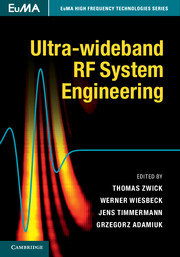Preface
Published online by Cambridge University Press: 05 December 2013
Summary
For many scientists and engineers working in ultra-wideband technology, it seems that the idea of using signals with such a wide instantaneous bandwidth was spread by the US FCC with the accreditation of the frequency band from 3.1 to 10.6 GHz. But, if we look back in history, we find that even the first man-made electromagnetic waves were generated by sparks. Especially famous for electromagnetic research was Heinrich Hertz who, in the 1880s, verified the speed of propagation of electromagnetic waves, their polarization and interaction with objects, and the correct description of these waves by Maxwell's equations at our university in Karlsruhe, Germany. Before this time, electromagnetic waves could only be generated by the aforementioned sparks and were thus ultra-wideband.
Ultra-wideband was banned in the 1920s because it occupied too great a portion of the spectrum and from this point was primarily limited to military applications. This was until 1992 when Leopold Felsen, Lawrence Carin, and Henry Bertoni organized a conference on ultra-wideband, short-pulse electromagnetics in Brooklyn. Our institution, the Institut für Höchstfrequenztechnik und Elektronik (now the Institut für Hochfrequenztechnik und Elektronik) had the privilege of participating in this first conference on ultra-wideband. The topics at the conference were so fascinating that we decided to step into this area. The first research topics were in ground penetration radar, with the idea of detecting anti-personnel mines.
- Type
- Chapter
- Information
- Ultra-wideband RF System Engineering , pp. ixPublisher: Cambridge University PressPrint publication year: 2013



